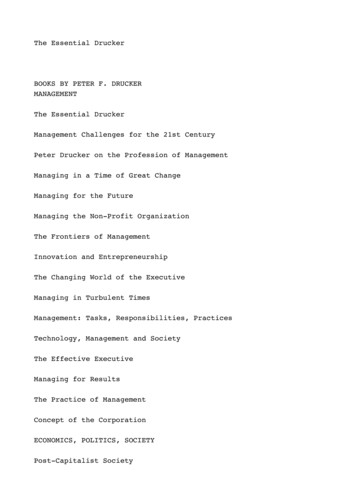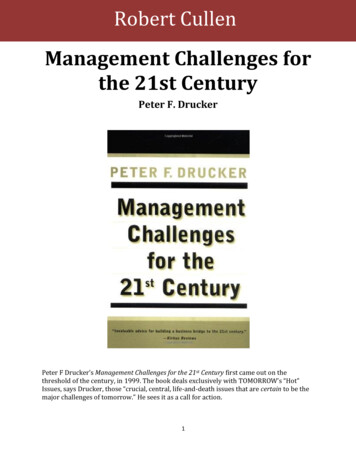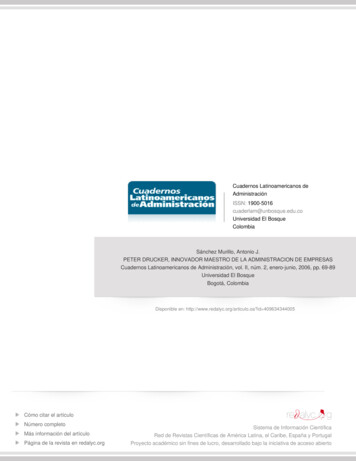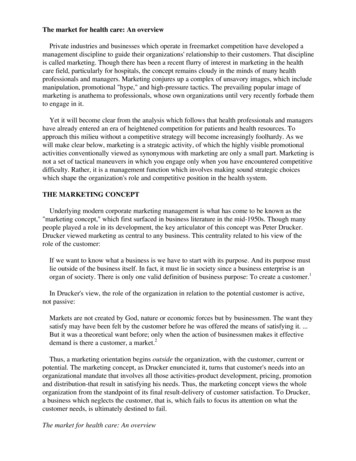
Transcription
The Essential DruckerBOOKS BY PETER F. DRUCKERMANAGEMENTThe Essential DruckerManagement Challenges for the 21st CenturyPeter Drucker on the Profession of ManagementManaging in a Time of Great ChangeManaging for the FutureManaging the Non-Profit OrganizationThe Frontiers of ManagementInnovation and EntrepreneurshipThe Changing World of the ExecutiveManaging in Turbulent TimesManagement: Tasks, Responsibilities, PracticesTechnology, Management and SocietyThe Effective ExecutiveManaging for ResultsThe Practice of ManagementConcept of the CorporationECONOMICS, POLITICS, SOCIETYPost-Capitalist Society
Drucker on AsiaThe Ecological RevolutionThe New RealitiesToward the Next EconomicsThe Pension Fund RevolutionMen, Ideas, and PoliticsThe Age of DiscontinuityLandmarks of TomorrowAmerica’s Next Twenty YearsThe New SocietyThe Future of Industrial ManThe End of Economic ManAUTOGRAPHYAdventures of a BystanderFICTIONThe Temptation to Do GoodThe Last of all Possible -------------------------------A DF Books NERDs Release
THE ESSENTIAL DRUCKER. Copyright 2001 Peter F. Drucker. Allrights reserved under international and Pan-American CopyrightConventions. By payment of the required fees, you have beengranted the non-exclusive, non-transferable license to access andread the text of this e-book on screen. No part of this text maybe reproduced, transmitted, down-loaded, decompiled, reverseengineered, or stored in or introduced into any informationstorage and retrieval system, in any form or by any means, whetherelectronic or mechanical, now known or hereinafter invented,without the express written permission of PerfectBound .PerfectBound and the PerfectBound logo are trademarks ofHarperCollins PublishersMobipocket Reader edition v 1. May 2001 ISBN: 0-0607-7132-1Print edition first published in 2001 by HarperCollinsPublishers, Inc.10 9 8 7 6 5 4 3 2 --------------------------CONTENTSIntroduction: The Origin and Purpose ofThe Essential DruckerI. MANAGEMENT1.2.3.4.5.6.Management as Social Function and Liberal ArtThe Dimensions of ManagementThe Purpose and objectives of a BusinessWhat the Nonprofits Are Teaching BusinessSocial Impacts and Social ProblemsManagement’s New Paradigms
7. The Information Executives Need Today8. Management by Objectives and Self-Control9. Picking People—The Basic Rules10. The Entrepreneurial Business11. The New Venture12. Entrepreneurial StrategiesII. THE INDIVIDUAL13. Effectiveness Must Be Learned14. Focus on Contribution15. Know Your Strengths and Values16. Know Your Time17. Effective Decisions18. Functioning Communications19. Leadership as Work20. Principles of Innovation21. The Second Half of Your Life22. The Educated PersonIII. SOCIETY23. A Century of Social Transformation—Emergence of KnowledgeSociety24. The Coming of Entrepreneurial Society25. Citizenship through the Social Sector26. From Analysis to Perception—The New WorldviewAfterword: The Challenge AheadAbout the AuthorCreditsAbout the PublisherINTRODUCTION:THE ORIGIN AND PURPOSE OFTHE ESSENTIAL DRUCKERThe Essential Drucker is a selection from my sixty years ofwork and writing on management. It begins with my book The Futureof Industrial Man (1942) and ends (so far at least) with my 1999book Management Challenges for the 21st Century.The Essential Drucker has two purposes. First, it offers, Ihope, a coherent and fairly comprehensive Introduction toManagement. But second, it gives an Overview of my works onmanagement and thus answers a question that my editors and I havebeen asked again and again, Where do I start to read Drucker?Which of his writings are essential?
Atsuo Ueda, longtime Japanese friend, first conceived TheEssential Drucker. He himself has had a distinguished career inJapanese management. And having reached the age of sixty, herecently started a second career and became the founder and chiefexecutive officer of a new technical university in Tokyo. But forthirty years Mr. Ueda has also been my Japanese translator andeditor. He has actually translated many of my books several timesas they went into new Japanese editions. He is thus thoroughlyfamiliar with my work—in fact, he knows it better than I do. As aresult he increasingly got invited to conduct Japanese conferencesand seminars on my work and found himself being asked over andover again—especially by younger people, both students andexecutives at the start of their careers—Where do I start readingDrucker?This led Mr. Ueda to reread my entire work, to select from itthe most pertinent chapters and to abridge them so that they readas if they had originally been written as one cohesive text. Theresult was a three-volume essential Drucker of fifty-sevenchapters—one volume on the management of organizations; one volumeon the individual in the society of organizations; one on societyin general—which was published in Japan in the summer and fall of2000 and has met with great success. It is also being published inTaiwan, mainland China and Korea, and in Argentina, Mexico, andBrazil.It is Mr. Ueda’s text that is being used for the U.S. and U.K.editions of The Essential Drucker. But these editions not only areless than half the size of Mr. Ueda’s original Japaneseversion—twenty-six chapters versus the three-volumes’ fifty-seven.They also have a somewhat different focus. Cass Canfield Jr. atHarperCollins in the United States—longtime friend and my U.S.editor for over thirty years—also came to the conclusion a fewyears ago that there was need for an introduction to, and overviewof, my sixty years of management writings. But he—rightly—saw thatthe U.S. and U.K. (and probably altogether the Western) audiencefor such a work would be both broader and narrower than theaudience for the Japanese venture. It would be broader becausethere is in the West a growing number of people who, while notthemselves executives, have come to see management as an area ofpublic interest; there are also an increasing number of studentsin colleges and universities who, while not necessarily managementstudents, see an understanding of management as part of a general
education; and, finally, there are a large and rapidly growingnumber of mid-career managers and professionals who are flockingto advanced-executive programs, both in universities and in theiremploying organizations. The focus would, however, also benarrower because these additional audiences need and want less anintroduction to, and overview of, Drucker’s work than they want aconcise, comprehensive, and sharply focused Introduction toManagement, and to management alone. And thus, while using Mr.Ueda’s editing and abridging, Cass Canfield Jr. (with my full,indeed my enthusiastic, support) selected and edited the textsfrom the Japanese three-volume edition into a comprehensive,cohesive, and self-contained introduction to management—both ofthe management of an enterprise and of the self-management of theindividual, whether executive or professional, within anenterprise and altogether in our society of managed organizations.My readers as well as I owe to both Atsuo Ueda and CassCanfield Jr. an enormous debt of gratitude. The two put anincredible amount of work and dedication into The EssentialDrucker. And the end product is not only the best introduction toone’s work any author could possibly have asked for. It is also, Iam convinced, a truly unique, cohesive, and self-containedintroduction to management, its basic principles and concerns; itsproblems, challenges, opportunities.This volume, as said before, is also an overview of my works onmanagement. Readers may therefore want to know where to go in mybooks to further pursue this or that topic or this or that area ofparticular interest to them. Here, therefore, are the sources inmy books for each of twenty-six chapters of the The EssentialDrucker:Chapter 1 and 26 are excerpted from The New Realities (1988).Chapters 2, 3, 5, 18 are excerpted from Management, Tasks,Responsibilities, Practices (1974).Chapters 4 and 19 are excerpted from Managing for the Future(1992), and were first published in the Harvard Business Review(1989) and in the Wall Street Journal (1988), respectively.Chapters 6, 15, and 21 are excerpted from Management Challengesfor the 21st Century (1999).
Chapters 7 and 23 are excerpted from Management in a Time ofGreat Change (1995) and were first published in the HarvardBusiness Review (1994) and in the Atlantic Monthly (1996),respectively.Chapter 8 was excerpted from The Practice of Management (1954).Chapter 9 was excerpted from The Frontiers of Management (1986)and was first published in the Harvard Business Review (1985).Chapters 10, 11, 12, 20, 24 were excerpted from Innovation andEntrepreneurship (1985).Chapters 13, 14, 16, 17 were excerpted from The EffectiveExecutive (1966).Chapters 22 and 25 were excerpted from Post-Capitalist Society(1993).All these books are still in print in the United States and inmany other countries.This one-volume edition of The Essential Drucker does not,however, include any excerpts from five important Management booksof mine: The Future of Industrial Man (1942); Concept of theCorporation (1946); Managing for Results (1964; the first book onwhat is now called “strategy,” a term unknown for business fortyyears ago); Managing in Turbulent Times (1980); Managing theNon-Profit Organization (1990). These are important books andstill widely read and used. But their subject matter is morespecialized—and in some cases also more technical—than that of thebooks from which the chapters of the present book were chosen—andthus had to be left out of a work that calls itself Essential.—Peter F. DruckerClaremont, CaliforniaSpring 2001I.
MANAGEMENT1.MANAGEMENT ASSOCIAL FUNCTION ANDLIBERAL ARTWhen Karl Marx was beginning work on Das Kapital in the 1850s,the phenomenon of management was unknown. So were the enterprisesthat managers run. The largest manufacturing company around was aManchester cotton mill employing fewer than three hundred peopleand owned by Marx’s friend and collaborator Friedrich Engels. Andin Engels’s mill—one of the most profitable businesses of itsday—there were no “managers,” only “charge hands” who, themselvesworkers, enforced discipline over a handful of fellow“proletarians.”Rarely in human history has any institution emerged as quicklyas management or had as great an impact so fast. In less than 150years, management has transformed the social and economic fabricof the world’s developed countries. It has created a globaleconomy and set new rules for countries that would participate inthat economy as equals. And it has itself been transformed. Fewexecutives are aware of the tremendous impact management has had.Indeed, a good many are like M. Jourdain, the character inMolière’s Bourgeois Gentilhomme, who did not know that he spokeprose. They barely realize that they practice—ormispractice—management. As a result, they are ill prepared for thetremendous challenges that now confront them. The truly importantproblems managers face do not come from technology or politics;they do not originate outside of management and enterprise. Theyare problems caused by the very success of management itself.To be sure, the fundamental task of management remains thesame: to make people capable of joint performance through commongoals, common values, the right structure, and the training anddevelopment they need to perform and to respond to change. But thevery meaning of this task has changed, if only because theperformance of management has converted the workforce from onecomposed largely of unskilled laborers to one of highly educatedknowledge workers.The Origins and Development of ManagementOn the threshold of World War I, a few thinkers were justbecoming aware of management’s existence. But few people even inthe most advanced countries had anything to do with it. Now the
largest single group in the labor force, more than one-third ofthe total, are people whom the U.S. Bureau of the Census calls“managerial and professional.” Management has been the main agentof this transformation. Management explains why, for the firsttime in human history, we can employ large numbers ofknowledgeable, skilled people in productive work. No earliersociety could do this. Indeed, no earlier society could supportmore than a handful of such people. Until quite recently, no oneknew how to put people with different skills and knowledgetogether to achieve common goals.Eighteenth-century China was the envy of contemporary Westernintellectuals because it supplied more jobs for educated peoplethan all of Europe did—some twenty thousand per year. Today, theUnited States, with about the same population China then had,graduates nearly a million college students a year, few of whomhave the slightest difficulty finding well-paid employment.Management enables us to employ them.Knowledge, especially advanced knowledge, is alwaysspecialized. By itself it produces nothing. Yet a modern business,and not only the largest ones, may employ up to ten thousandhighly knowledgeable people who represent up to sixty differentknowledge areas. Engineers of all sorts, designers, marketingexperts, economists, statisticians, psychologists, planners,accountants, human-resources people—all working together in ajoint venture. None would be effective without the managedenterprise.There is no point in asking which came first, the educationalexplosion of the last one hundred years or the management that putthis knowledge to productive use. Modern management and modernenterprise could not exist without the knowledge base thatdeveloped societies have built. But equally, it is management, andmanagement alone, that makes effective all this knowledge andthese knowledgeable people. The emergence of management hasconverted knowledge from social ornament and luxury into the truecapital of any economy.Not many business leaders could have predicted this developmentback in 1870, when large enterprises were first beginning to takeshape. The reason was not so much lack of foresight as lack ofprecedent. At that time, the only large permanent organizationaround was the army. Not surprisingly, therefore, its
command-and-control structure became the model for the men whowere putting together transcontinental railroads, steel mills,modern banks, and department stores. The command model, with avery few at the top giving orders and a great many at the bottomobeying them, remained the norm for nearly one hundred years. Butit was never as static as its longevity might suggest. On thecontrary, it began to change almost at once, as specializedknowledge of all sorts poured into enterprise.The first university-trained engineer in manufacturing industrywas hired by Siemens in Germany in 1867—his name was Friedrich vonHefner-Alteneck. Within five years he had built a researchdepartment. Other specialized departments followed suit. By WorldWar I the standard functions of a manufacturer had been developed:research and engineering, manufacturing, sales, finance andaccounting, and a little later, human resources (or personnel).Even more important for its impact on enterprise—and on theworld economy in general—was another management-directeddevelopment that took place at this time. That was the applicationof management to manual work in the form of training. The child ofwartime necessity, training has propelled the transformation ofthe world economy in the last forty years because it allowslow-wage countries to do something that traditional economictheory had said could never be done: to become efficient—and yetstill low-wage—competitors almost overnight.Adam Smith reported that it took several hundred years for acountry or region to develop a tradition of labor and theexpertise in manual and managerial skills needed to produce andmarket a given product, whether cotton textiles or violins.During World War I, however, large numbers of unskilled,preindustrial people had to be made productive workers inpractically no time. To meet this need, businesses in the UnitedStates and the United Kingdom began to apply the theory ofscientific management developed by Frederick W. Taylor between1885 and 1910 to the systematic training of blue-collar workers ona large scale. They analyzed tasks and broke them down intoindividual, unskilled operations that could then be learned quitequickly. Further developed in World War II, training was thenpicked up by the Japanese and, twenty years later, by the SouthKoreans, who made it the basis for their countries’ phenomenaldevelopment.
During the 1920s and 1930s, management was applied to many moreareas and aspects of the manufacturing business. Decentralization,for instance, arose to combine the advantages of bigness and theadvantages of smallness within one enterprise. Accounting wentfrom “bookkeeping” to analysis and control. Planning grew out ofthe “Gantt charts” designed in 1917 and 1918 to plan warproduction; and so did the use of analytical logic and statistics,which employ quantification to convert experience and intuitioninto definitions, information, and diagnosis. Marketing evolved asa result of applying management concepts to distribution andselling. Moreover, as early as the mid-1920s and early 1930s, someAmerican management pioneers such as Thomas Watson Sr. at thefledgling IBM; Robert E. Wood at Sears, Roebuck; and George EltonMayo at the Harvard Business School began to question the waymanufacturing was organized. They concluded that the assembly linewas a short-term compromise. Despite its tremendous productivity,it was poor economics because of its inflexibility, poor use ofhuman resources, even poor engineering. They began the thinkingand experimenting that eventually led to “automation” as the wayto organize the manufacturing process, and to teamwork, qualitycircles, and the information-based organization as the way tomanage human resources. Every one of these managerial innovationsrepresented the application of knowledge to work, the substitutionof system and information for guesswork, brawn, and toil. Everyone, to use Frederick Taylor’s term, replaced “working harder”with “working smarter.”The powerful effect of these changes became apparent duringWorld War II. To the very end, the Germans were by far the betterstrategists. Having much shorter interior lines, they needed fewersupport troops and could match their opponents in combat strength.Yet the Allies won—their victory achieved by management. TheUnited States, with one-fifth the population of all the otherbelligerents combined, had almost as many men in uniform. Yet itproduced more war materiél than all the others taken together. Itmanaged to transport the stuff to fighting fronts as far apart asChina, Russia, India, Africa, and Western Europe. No wonder, then,that by the war’s end almost all the world had becomemanagement-conscious. Or that management emerged as a recognizablydistinct kind of work, one that could be studied and developedinto a discipline—as happened in each country that has enjoyedeconomic leadership during the postwar period.
After World War II we began to see that management is notexclusively business management. It pertains to every human effortthat brings together in one organization people of diverseknowledge and skills. It needs to be applied to all third-sectorinstitutions, such as hospitals, universities, churches, artsorganizations, and social service agencies, which since World WarII have grown faster in the United States than either business orgovernment. For even though the need to manage volunteers or raisefunds may differentiate nonprofit managers from their for-profitpeers, many more of their responsibilities are the same—among themdefining the right strategy and goals, developing people,measuring performance, and marketing the organization’s services.Management worldwide has become the new social function.Management and EntrepreneurshipOne important advance in the discipline and practice ofmanagement is that both now embrace entrepreneurship andinnovation. A sham fight these days pits “management” against“entrepreneurship” as adversaries, if not as mutually exclusive.That’s like saying that the fingering hand and the bow hand of theviolinist are “adversaries” or “mutually exclusive.” Both arealways needed and at the same time. And both have to becoordinated and work together. Any existing organization, whethera business, a church, a labor union, or a hospital, goes down fastif it does not innovate. Conversely, any new organization, whethera business, a church, a labor union, or a hospital, collapses ifit does not manage. Not to innovate is the single largest reasonfor the decline of existing organizations. Not to know how tomanage is the single largest reason for the failure of newventures.Yet few management books have paid attention toentrepreneurship and innovation. One reason is that during theperiod after World War II when most of those books were written,managing the existing rather than innovating the new and differentwas the dominant task. During this period most institutionsdeveloped along lines laid down thirty or fifty years earlier.This has now changed dramatically. We have again entered an era ofinnovation, and it is by no means confined to “high-tech” or totechnology generally. In fact, social innovation—as this chaptertries to make clear—may be of greater importance and have muchgreater impact than any scientific or technical invention.Furthermore, we now have a “discipline” of entrepreneurship andinnovation (see my Innovation and Entrepreneurship, 1986). It is
clearly a part of management and rests, indeed, on well-known andtested management principles. It applies to both existingorganizations and new ventures, and to both business andnonbusiness institutions, including government.The Accountability of ManagementManagement books tend to focus on the function of managementinside its organization. Few yet accept it as a social function.But it is precisely because management has become so pervasive asa social function that it faces its most serious challenge. Towhom is management accountable? And for what? On what doesmanagement base its power? What gives it legitimacy?These are not business questions or economic questions. Theyare political questions. Yet they underlie the most seriousassault on management in its history—a far more serious assaultthan any mounted by Marxists or labor unions: the hostiletakeover. An American phenomenon at first, it has spreadthroughout the non-Communist developed world. What made itpossible was the emergence of the employee pension funds as thecontrolling shareholders of publicly owned companies. The pensionfunds, while legally “owners,” are economically “investors”—and,indeed, often “speculators.” They have no interest in theenterprise and its welfare. In fact, in the United States at leastthey are “trustees,” and are not supposed to consider anything butimmediate pecuniary gain. What underlies the takeover bid is thepostulate that the enterprise’s sole function is to provide thelargest possible immediate gain to the shareholder. In the absenceof any other justification for management and enterprise, the“raider” with his hostile takeover bid prevails—and only too oftenimmediately dismantles or loots the going concern, sacrificinglong-range, wealth-producing capacity to short-term gains.Management—and not only in the business enterprise—has to beaccountable for performance. But how is performance to be defined?How is it to be measured? How is it to be enforced? And to whomshould management be accountable? That these questions can beasked is in itself a measure of the success and importance ofmanagement. That they need to be asked is, however, also anindictment of managers. They have not yet faced up to the factthat they represent power—and power has to be accountable, has tobe legitimate. They have not yet faced up to the fact that theymatter.
What Is Management?But what is management? Is it a bag of techniques and tricks? Abundle of analytical tools like those taught in business schools?These are important, to be sure, just as thermometer and anatomyare important to the physician. But the evolution and history ofmanagement—its successes as well as its problems—teach thatmanagement is, above all else, based on a very few, essentialprinciples. To be specific:Management is about human beings. Its task is to make peoplecapable of joint performance, to make their strengths effectiveand their weaknesses irrelevant. This is what organization is allabout, and it is the reason that management is the critical,determining factor. These days, practically all of us work for amanaged institution, large or small, business or nonbusiness. Wedepend on management for our livelihoods. And our ability tocontribute to society also depends as much on the management ofthe organization for which we work as it does on our own skills,dedication, and effort.Because management deals with the integration of people in acommon venture, it is deeply embedded in culture. What managers doin West Germany, in the United Kingdom, in the United States, inJapan, or in Brazil is exactly the same. How they do it may bequite different. Thus one of the basic challenges managers in adeveloping country face is to find and identify those parts oftheir own tradition, history, and culture that can be used asmanagement building blocks. The difference between Japan’seconomic success and India’s relative backwardness is largelyexplained by the fact that Japanese managers were able to plantimported management concepts in their own cultural soil and makethem grow.Every enterprise requires commitment to common goals and sharedvalues. Without such commitment there is no enterprise; there isonly a mob. The enterprise must have simple, clear, and unifyingobjectives. The mission of the organization has to be clear enoughand big enough to provide common vision. The goals that embody ithave to be clear, public, and constantly reaffirmed. Management’sfirst job is to think through, set, and exemplify thoseobjectives, values, and goals.Management must also enable the enterprise and each of itsmembers to grow and develop as needs and opportunities change.Every enterprise is a learning and teaching institution. Trainingand development must be built into it on all levels—training anddevelopment that never stop.
Every enterprise is composed of people with different skillsand knowledge doing many different kinds of work. It must be builton communication and on individual responsibility. All membersneed to think through what they aim to accomplish—and make surethat their associates know and understand that aim. All have tothink through what they owe to others—and make sure that othersunderstand. All have to think through what they in turn need fromothers—and make sure that others know what is expected of them.Neither the quantity of output nor the “bottom line” is byitself an adequate measure of the performance of management andenterprise. Market standing, innovation, productivity, developmentof people, quality, financial results—all are crucial to anorganization’s performance and to its survival. Nonprofitinstitutions too need measurements in a number of areas specificto their mission. Just as a human being needs a diversity ofmeasures to assess his or her health and performance, anorganization needs a diversity of measures to assess its healthand performance. Performance has to be built into the enterpriseand its management; it has to be measured—or at least judged—andit has to be continually improved.Finally, the single most important thing to remember about anyenterprise is that results exist only on the outside. The resultof a business is a satisfied customer. The result of a hospital isa healed patient. The result of a school is a student who haslearned something and puts it to work ten years later. Inside anenterprise, there are only costs.Managers who understand these principles and function in theirlight will be achieving, accomplished managers.Management as a Liberal ArtThirty years ago the English scientist and novelist C. P. Snowtalked of the “two cultures” of contemporary society. Management,however, fits neither Snow’s “humanist” nor his “scientist.” Itdeals with action and application; and its test is results. Thismakes it a technology. But management also deals with people,their values, their growth and development—and this makes it ahumanity. So does its concern with, and impact on, socialstructure and the community. Indeed, as everyone has learned who,like this author, has been working with managers of all kinds ofinstitutions for long years, management is deeply involved inmoral concerns—the nature of man, good and evil.Management is thus what tradition used to call a liberalart—“liberal” because it deals with the fundamentals of knowledge,
self-knowledge, wisdom, and leadership; “art” because it is alsoconcerned with practice and application. Managers draw on all theknowledges and insights of the humanities and the socialsciences—on psychology and philosophy, on economics and history,on ethics—as well as on the physical sciences. But they have tofocus this knowledge on effectiveness and results—on healing asick patient, teaching a student, building a bridge, designing andselling a “user-friendly” software program.For these reasons, management will increasingly be thediscipline and the practice through which the “humanities” willagain acquire recognition, impact, and relevance.2.THE DIMENSIONSOF MANAGEMENTBusiness enterprises—and public-service institutions aswell—are organs of society. They do not exist for their own sake,but to fulfill a specific social purpose and to satisfy a specificneed of a society, a community, or individuals. They are not endsin themselves,
(1992), and were first published in the Harvard Business Review (1989) and in the Wall Street Journal (1988), respectively. Chapters 6, 15, and 21 are excerpted from Management










